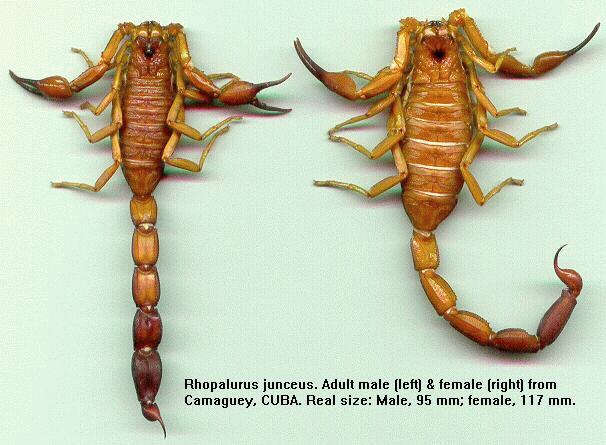Rhopalurus junceus |
||
|
|
|
Common names:
Distribution:
Carribean (Cuba and Hati) and South-America (Venezuela).
Habitat:
This is an habitat generalist, lives in all types of
forests (from dry coastal to rainy montane ones),
savannas and semidesertic areas. Found under stones,
fallen tree trunks, inside epiphitic & terrestrial
Bromeliaceae, under barks up to 5m above the ground and
commonly enters houses (even in large cities). Does not
burrow, but eventually can dig short scrapes under a
stone or log to hide in.
Venom:
A LD 50 value of 8.0 mg/kg has been reported for this species. This
inidcates that this species isn't among the most venomous scorpions. This is the
most common scorpion in Cuba, and a lot of peoples are stung each year. No deaths have
been reported, with the exception of a few deaths due to anaphylactic shock following
a hypersensitivity immune reaction.
Selected litterature:
Cao, J., F. Rivera and f. Bello. 1997. Algunos aspectos bioecologicos y
farmacologicos del veneno crudo procedente de dos especies de
escorpiones cubanos. Resumenes IV Simposio de Zoologia, La Habana,
p. 70.
On the Internet:
General:
What has been referred as "R. junceus" so far,
is actually a species complex currently under revision by
Dr. Rolano Teruel in Cuba. Preliminary results have IDed
at least three species new to science, which will be
formally described soon.
This species is known to be kept in captivity in Europe
(Germany, Czech Rep.), where it is also been bred
succesfully several times. Life span in captivity: about
3-6 years.
This is one of the few scorpion species which produce a
strongly audible stridulatory sound when disturbed.
This species file is written by Dr.
Roleando Teruel.
Rhopalurus photo by Dr. Rolando Teruel (C)
